Hydrogen Sulfide Alleviates Oxidative Damage under Chilling Stress through Mitogen-Activated Protein Kinase in Tomato
Abstract
1. Introduction
2. Materials and Methods
2.1. Plant Material and Growth Conditions
2.2. Measurement of H2S Content and L-Cysteine Desulfhydrase (LCD) Activity
2.3. Antioxidant Enzyme Activity and Electrolyte Leakage (EL)
2.4. Determination of Hydrogen Peroxide (H2O2) Content and Superoxide Anion (O2−) Production Rate
2.5. Evaluation of Chlorophyll Fluorescence Parameters
2.6. Virus-Induced Gene Silencing (VIGS)
2.7. qRT-PCR Analysis
2.8. Statistical Analysis
3. Results and Discussion
3.1. Accumulation of H2S during Chilling Stress in Tomato Seedlings
3.2. NaHS Mitigated the Oxidative Damage Caused by Chilling Stress through the Regulation of Antioxidant Capacity
3.3. MPK Inhibitor Decreased the H2S Signal and Attenuated the Alleviating Effect of NaHS under Chilling Stress
3.4. SlMPK4 Expression was Increased by NaHS Treatment under Chilling Stress
3.5. H2S Regulated the Expression of Cold Response-Related Genes and RBOHs via MPK4
4. Discussion
4.1. H2S Signaling Plays an Important Role in Chilling Stress in Tomato
4.2. Relationship between H2S and MPK Cascades in Response to Chilling Stress
5. Conclusions
Author Contributions
Funding
Institutional Review Board Statement
Informed Consent Statement
Data Availability Statement
Conflicts of Interest
References
- Li, J.; Xiang, C.; Wang, X.; Guo, Y.; Huang, Z.; Liu, L.; Li, X.; Du, Y. Current situation of tomato industry in China during ‘The Thirteenth Five-year Plan’ period and future prospect. China Veg. 2021, 2, 13–20. [Google Scholar]
- Mei, Y.; Chen, H.; Shen, W.; Shen, W.; Huang, L. Hydrogen peroxide is involved in hydrogen sulfide-induced lateral root formation in tomato seedlings. BMC Plant Biol. 2017, 17, 162–173. [Google Scholar] [CrossRef]
- Zhang, Q.; Cai, W.; Ji, T.; Ye, L.; Lu, Y.; Yuan, T. WRKY13 enhances cadmium tolerance by promoting D-cysteine desulfhydrase and hydrogen sulfide production. Plant Physiol. 2020, 183, 345–357. [Google Scholar] [CrossRef]
- Khan, M.; Siddiqui, M.; Mukherjee, S. Calcium-hydrogen sulfide crosstalk during K+-deficient NaCl stress operates through regulation of Na+/H+ antiport and antioxidative defense system in mung bean roots. Plant Physiol. Biochem. 2021, 159, 211–225. [Google Scholar] [CrossRef]
- Wu, G.; Cai, B.; Zhou, C.; Li, D.; Bi, H.; Ai, X. Hydrogen sulfide-induced chilling tolerance of cucumber and involvement of nitric oxide. J. Plant Biol. Res. 2016, 5, 58–69. [Google Scholar]
- Zhao, C.; Zhu, J. The broad roles of CBF genes: From development to abiotic stress. Plant Signal. Behav. 2016, 11, 1215794. [Google Scholar] [CrossRef]
- Zhang, X.; Liu, F.; Zhai, J.; Li, F.; Bi, H.; Ai, X. Auxin acts as a downstream signaling molecule involved in hydrogen sulfide-induced chilling tolerance in cucumber. Planta 2020, 251, 69–87. [Google Scholar] [CrossRef]
- Fu, P.; Wang, W.; Hou, L.; Liu, X. Hydrogen sulfide is involved in the chilling stress response in Vitis vinifera L. Acta Soc. Bot. Pol. 2013, 56, 126–129. [Google Scholar] [CrossRef]
- Zhang, M.; Su, J.; Zhang, Y.; Xu, J.; Zhang, S. Conveying endogenous and exogenous signals: MAPK cascades in plant growth and defense. Curr. Opin. Plant Biol. 2018, 45, 1–10. [Google Scholar] [CrossRef]
- Xu, J.; Zhang, S. Mitogen-activated protein kinase cascades in signaling plant growth and development. Trends Plant Sci. 2015, 20, 56–64. [Google Scholar] [CrossRef] [PubMed]
- Ning, J.; Li, X.; Hicks, L.M. A Raf-like MAPKKK gene DSM1 mediates drought resistance through reactive oxygen species scavenging in rice. Plant Physiol. 2010, 152, 876–890. [Google Scholar] [CrossRef]
- Simone, D.; Oliveira, A.; Sousa, F.B.M.; Souza, L.K.M.; Pacheco, G.; Filgueiras, M.C.; Nicolau, L.A.D.; Brito, G.A.C.; Cerqueira, G.S.; Silva, R.O.; et al. AMPK activation promotes gastroprotection through mutual interaction with the gaseous mediators H2S, NO, and CO. Nitric Oxide 2018, 78, 60–71. [Google Scholar]
- Zhang, P.; Luo, Q.; Wang, R.; Xu, J. Hydrogen sulfide toxicity inhibits primary root growth through the ROS-NO pathway. Sci. Rep. 2017, 7, 868–878. [Google Scholar] [CrossRef]
- Liu, F.; Fu, X.; Wu, G.; Feng, Y.; Li, F.; Bi, H.; Ai, X. Hydrogen peroxide is involved in hydrogen sulfide-induced carbon assimilation and photoprotection in cucumber seedlings. Environ. Exp. Bot. 2020, 175, 104052. [Google Scholar] [CrossRef]
- Riemenschneider, A.; Nikiforova, V.; Hoefgen, R.; Luit, J.D.K.; Jutta, P. Impact of elevated H2S on metabolite levels, activity of enzymes and expression of genes involved in cysteine metabolism. Plant Physiol. Biochem. 2005, 43, 473–483. [Google Scholar] [CrossRef]
- Heath, R.L.; Packer, L. Photoperoxidation in isolated chloroplasts: I. kinetics and stoichiometry of fatty acid peroxidation. Arch. Biochem. Biophys. 1968, 125, 189–198. [Google Scholar] [CrossRef]
- Beyer, W.F.; Fridovich, I. Assaying for superoxide dismutase activity: Some large consequences of minor changes in conditions. Anal. Biochem. 1987, 161, 559–566. [Google Scholar] [CrossRef]
- Omran, R.G. Peroxide levels and the activities of catalase, peroxidase, and indoleacetic acid oxidase during and after chilling cucumber seedlings. Plant Physiol. 1980, 65, 407–408. [Google Scholar] [CrossRef]
- Nakano, Y.; Asada, K. Purifcation of ascorbate peroxidase in spinach chloroplasts; its inactivation in ascorbate-depleted medium and reactivation by monodehydroascorbate radical. Plant Cell Physiol. 1987, 28, 131–140. [Google Scholar]
- Dong, X.; Bi, H.; Wu, G.; Ai, X. Drought-induced chilling tolerance in cucumber involves membrane stabilisation improved by antioxidant system. Int. J. Plant Prod. 2013, 7, 67–80. [Google Scholar]
- Wang, A.G.; Luo, G.H. Quantitative relation between the reaction of hydroxylamine and superoxide anion radicals in plants. Plant Physiol. Commun. 1990, 6, 55–57. [Google Scholar]
- Zhang, M.; Zhang, S. Mitogen-activated protein kinase cascades in plant signaling. J. Integr. Plant Biol. 2022, 64, 301–341. [Google Scholar] [CrossRef]
- Wu, G.; Li, S.; Dong, Y.; Bi, H.; Ai, X. Exogenous hydrogen sulfide improves chilling tolerance by regulating hydrogen peroxide production in cucumber seedlings. Hortic. Environ. Biotechnol. 2022, 63, 651–663. [Google Scholar] [CrossRef]
- Khan, M.N.; Corpas, F.J. Plant hydrogen sulfide under physiological and adverse environments. Plant Physiol. Biochem. 2021, 161, 46–47. [Google Scholar] [CrossRef]
- Arif, M.B.A. Hydrogen sulfide: A versatile gaseous molecule in plants. Plant Physiol. Biochem. 2021, 158, 372–384. [Google Scholar] [CrossRef]
- Yang, T.; Yuan, G.; Zhang, Q.; Xuan, L.; Li, J.; Zhou, L.; Shi, H.; Wang, X.; Wang, C. Transcriptome and metabolome analyses reveal the pivotal role of hydrogen sulfide in promoting submergence tolerance in Arabidopsis. Environ. Exp. Bot. 2020, 183, 104365. [Google Scholar] [CrossRef]
- Guo, Z.; Liang, Y.; Yan, J.; Yang, E.; Li, K.; Xu, H. Physiological response and transcription profiling analysis reveals the role of H2S in alleviating excess nitrate stress tolerance in tomato roots. Plant Physiol. Biochem. 2018, 124, 59–69. [Google Scholar] [CrossRef]
- Ba, Y.; Zhai, J.; Yan, J.; Li, K.; Xu, H. H2S improves growth of tomato seedlings involving the MAPK signaling. Sci. Hortic. 2021, 288, 110366. [Google Scholar] [CrossRef]
- Du, X.; Jin, Z.; Liu, D.; Yang, G.; Pei, Y. Hydrogen sulfide alleviates the cold stress through MPK4 in Arabidopsis thaliana. Plant Physiol. Biochem. 2017, 120, 112–119. [Google Scholar] [CrossRef]
- Li, H.; Ding, Y.; Shi, Y.; Zhang, X.; Zhang, S.; Gong, Z.; Yang, S. MPK3-and MPK6-mediated ICE1 phosphorylation negatively regulates ICE1 stability and freezing tolerance in Arabidopsis. Dev. Cell 2017, 43, 630–642. [Google Scholar] [CrossRef]
- Zhao, C.; Wang, P.; Si, T.; Hsu, C.; Wang, L.; Zayed, O.; Yu, Z.; Zhu, Y.; Dong, J.; Tao, W.; et al. MAP kinase cascades regulate the cold response by modulating ICE1 protein stability. Dev. Cell 2017, 45, 618–629. [Google Scholar] [CrossRef]
- Neill, S.J.; Desikan, R.; Hancock, J. Hydrogen peroxide signalling. Curr. Opin. Plant Biol. 2002, 5, 388–395. [Google Scholar] [CrossRef]
- Scuffi, D.; Nietzel, T.; Di Fino, L.M.; Meyer, A.J.; Lamattina, L.; Schwarzlander, M.; Laxalt, A.M.; Garcia-Mata, C. Hydrogen sulfide increases production of NADPH oxidase-dependent hydrogen peroxide and phospholipase D-Derived phosphatidic acid in guard cell signaling. Plant Physiol. 2018, 176, 2532–2542. [Google Scholar] [CrossRef]
- Liu, Y.; He, C. A review of redox signaling and the control of MAP kinase pathway in plants. Redox Biol. 2017, 11, 192–204. [Google Scholar] [CrossRef]
- Yu, W.; Wang, L.; Zhao, R.; Sheng, J.; Zhang, S.; Li, R.; Shen, L. Knockout of SlMAPK3 enhances tolerance to heat stress involving ROS homeostasis in tomato plants. BMC Plant Biol. 2019, 19, 354–367. [Google Scholar] [CrossRef]

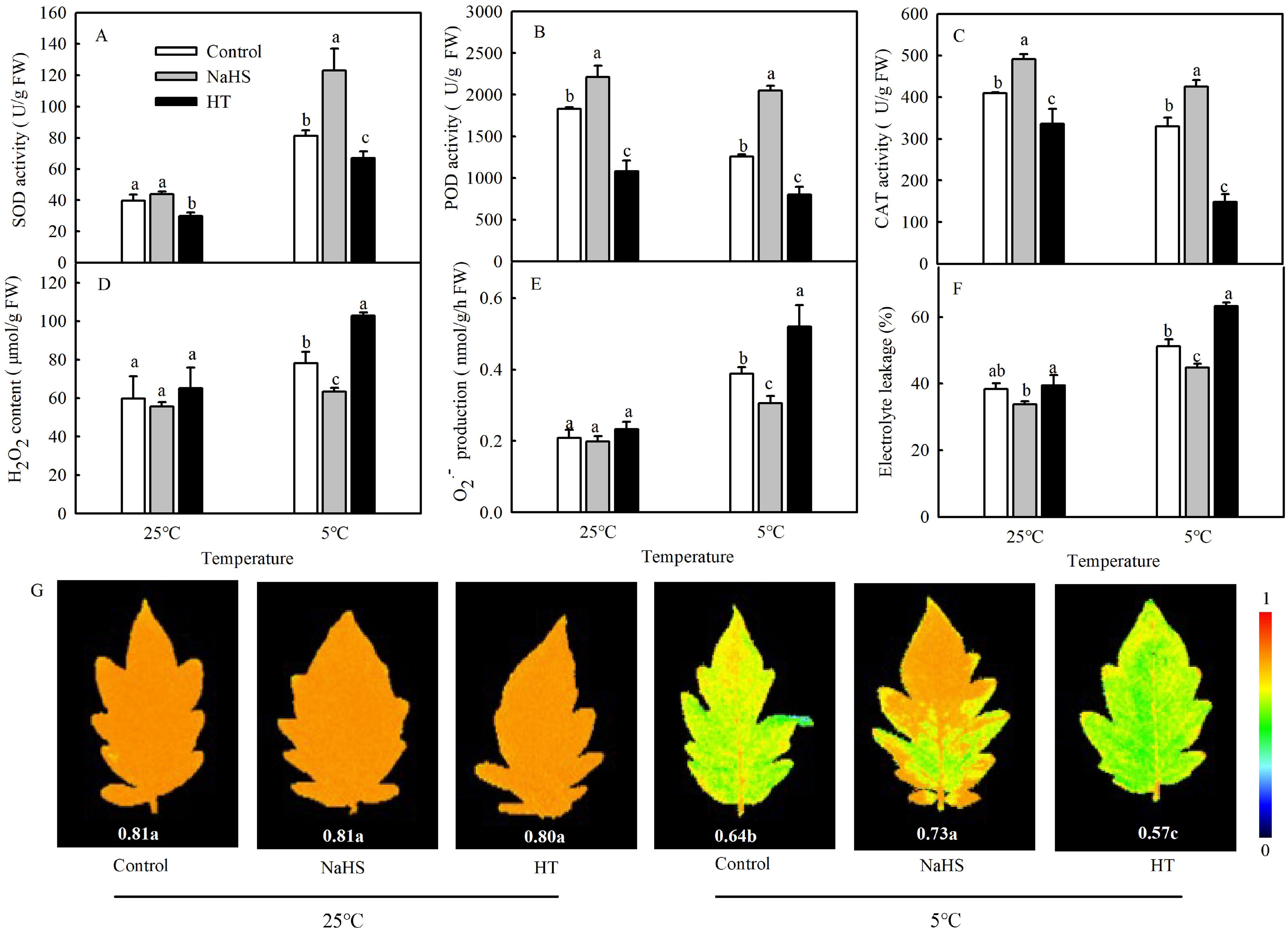
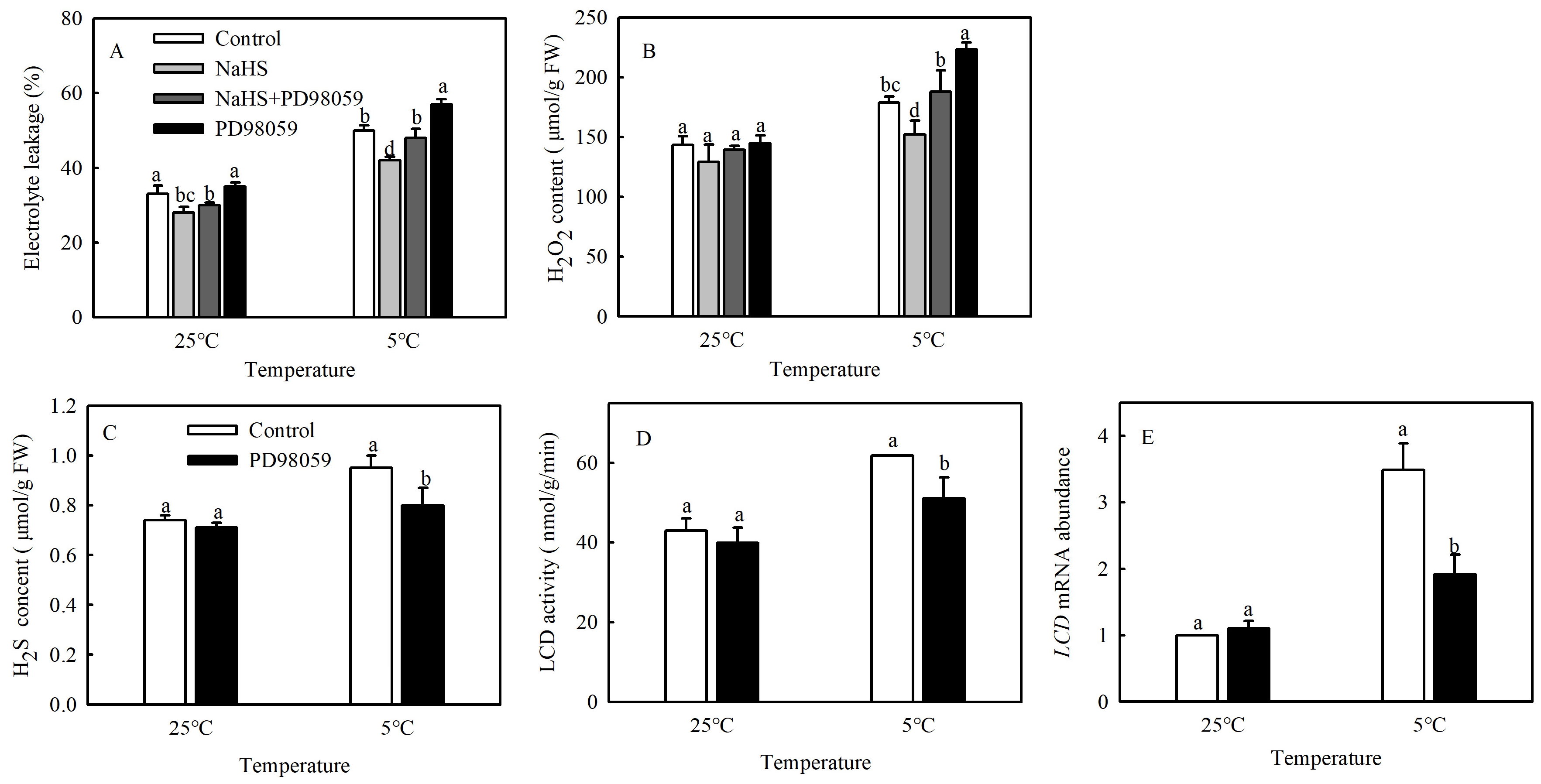
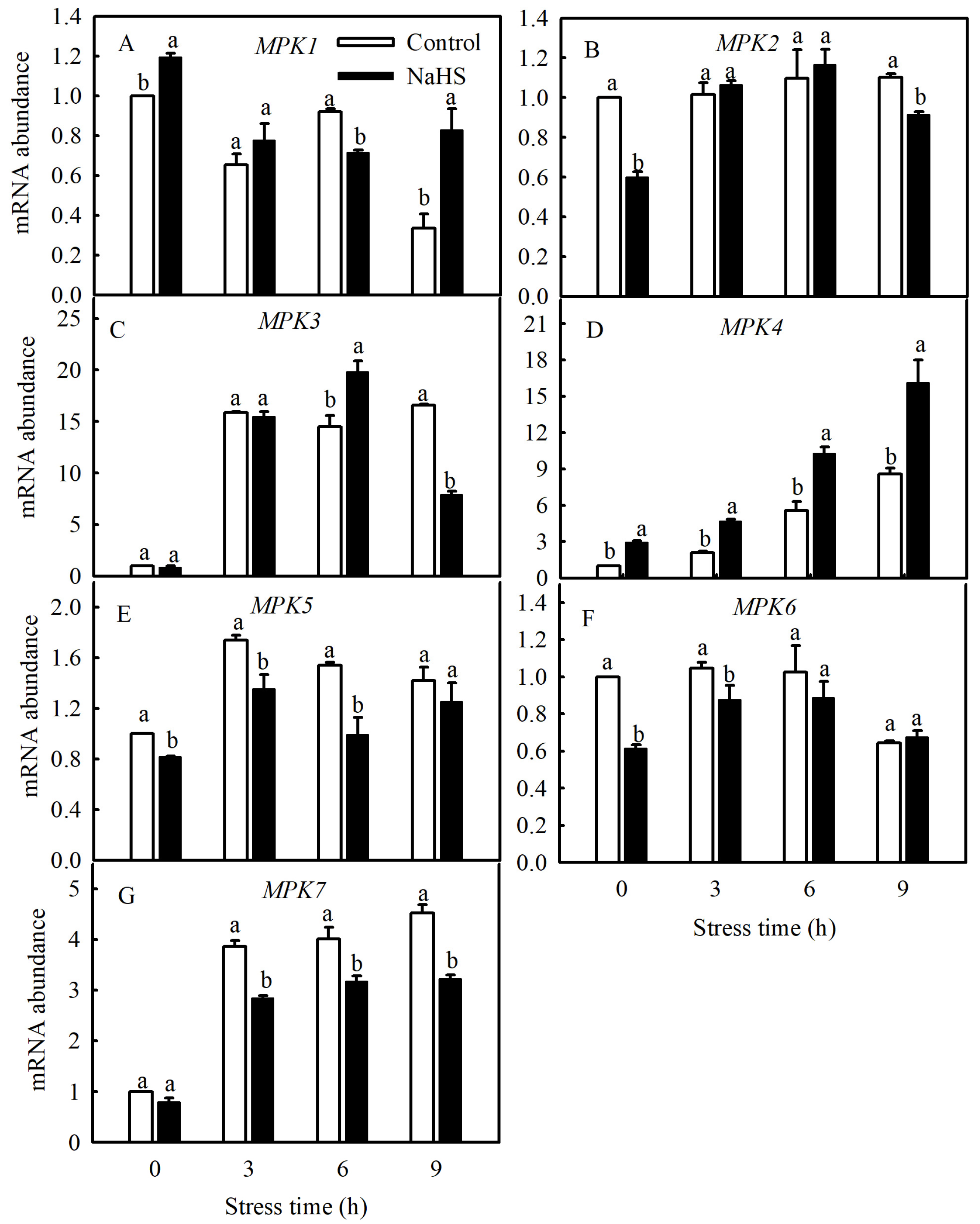
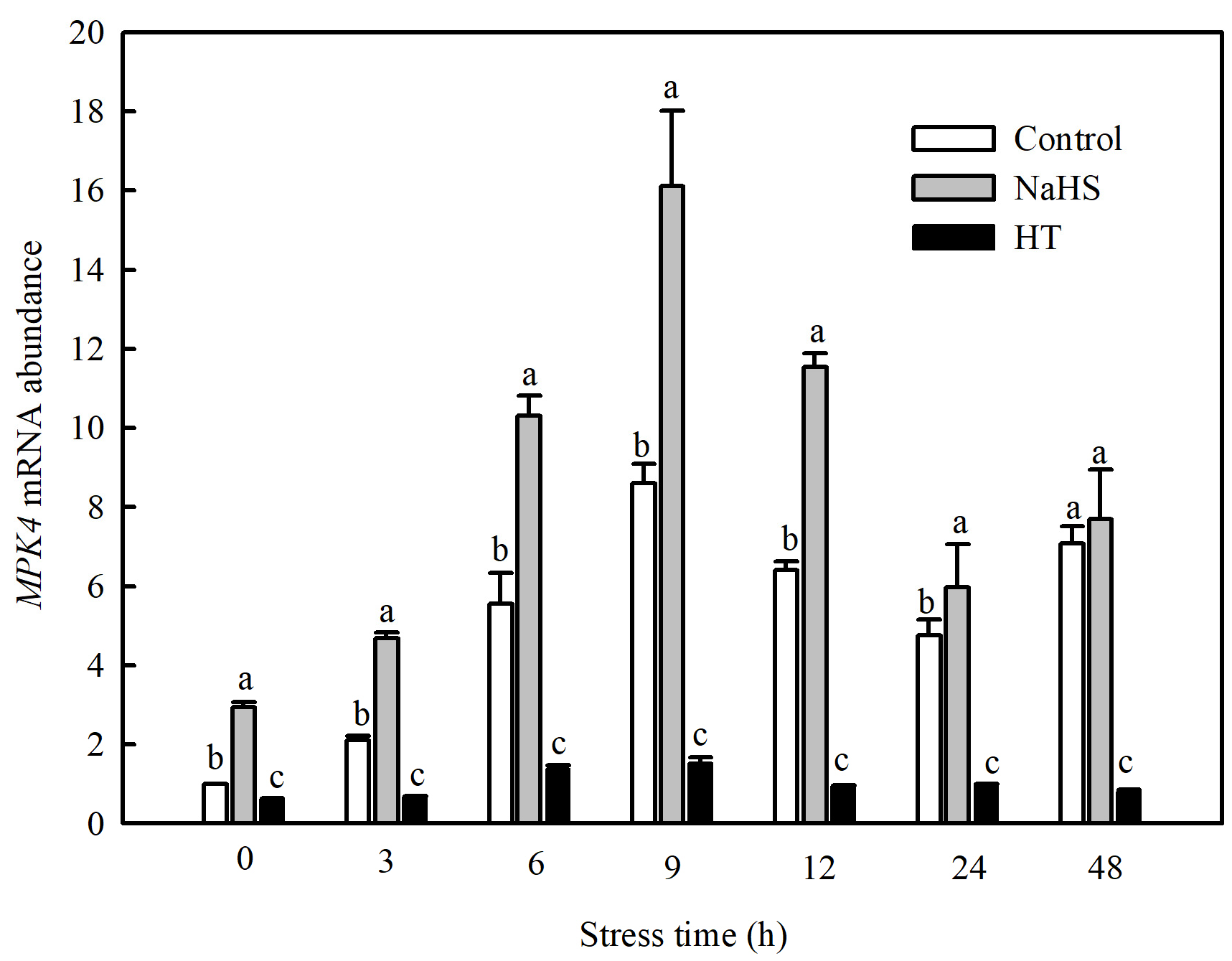

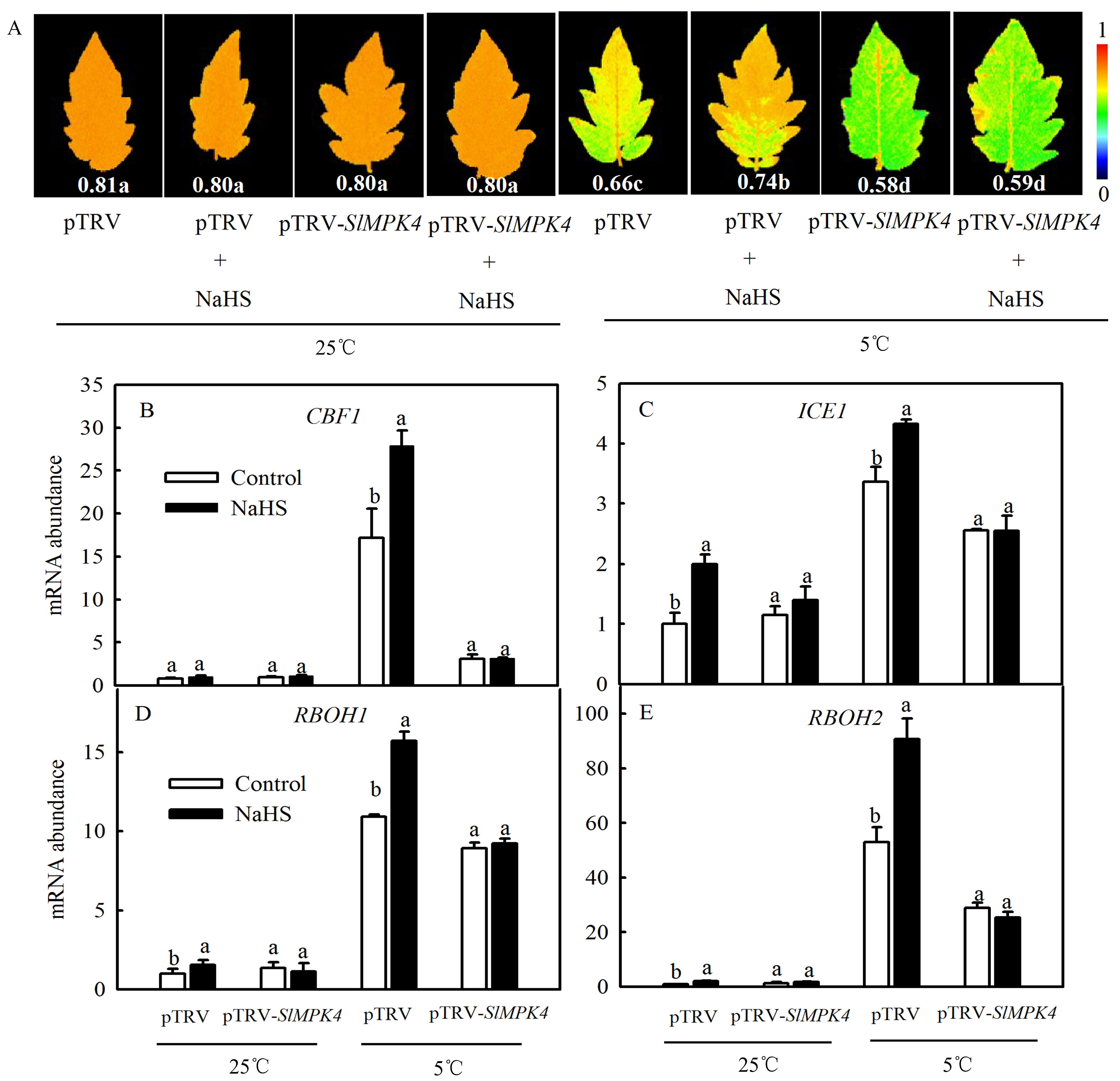
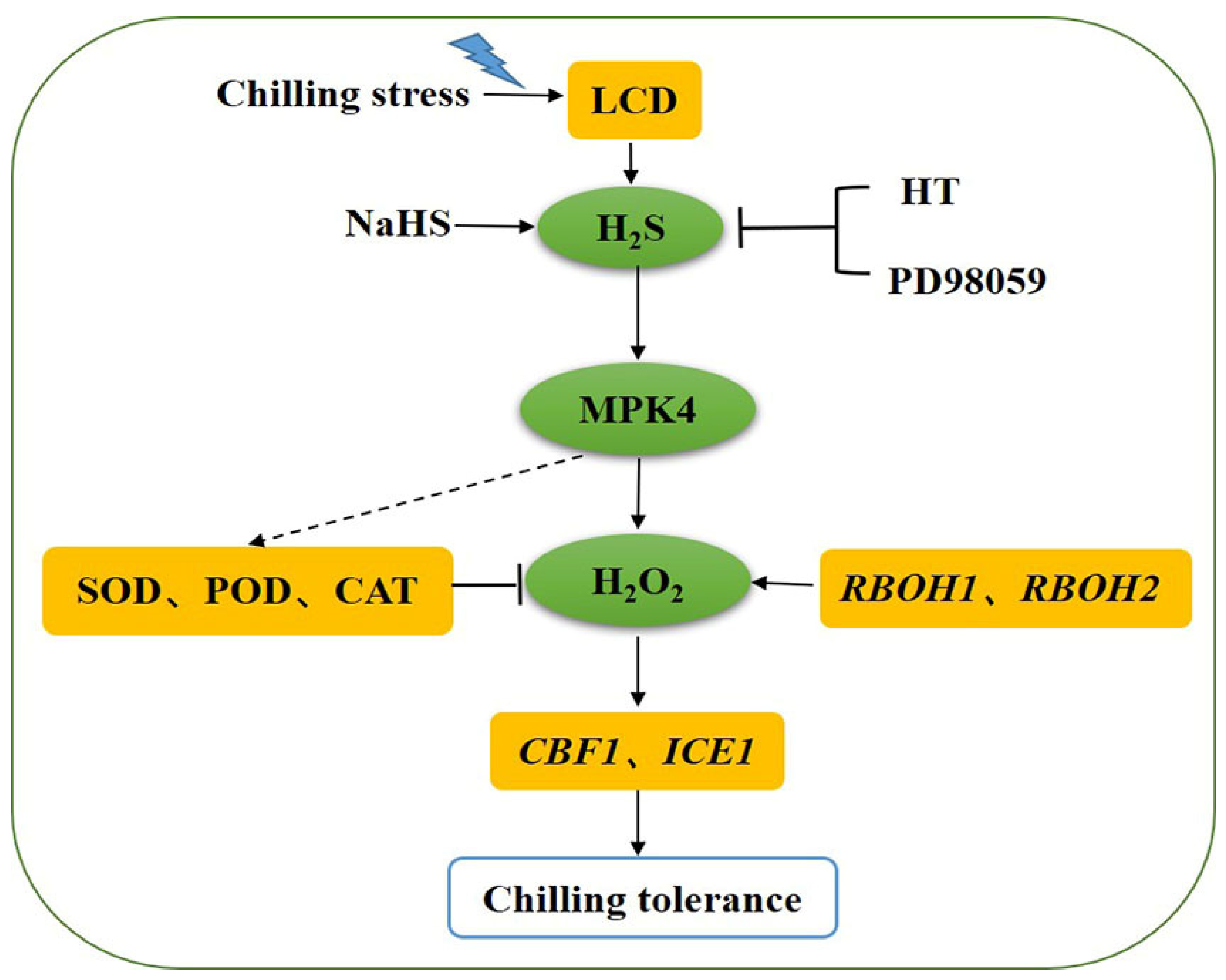
| Gene | Accession No. | Primer Name (5′→3′) | Primer Position | Amplicon Size (bp) |
|---|---|---|---|---|
| EF1a | NM_001247106 | F:5′-ATTGGAAACGGATATGCCCCT-3′ R:5′-TCCTTACCTGAACGCCTGTCA-3′ | 1106–1226 | 101 |
| LCD | XM_026030768 | F:5′-CATTTTGCGGTGGAAGTCCC-3′ R:5′-TAGTCGTTTGGCCCCATCTG-3′ | 1337–1558 | 222 |
| ICE1 | NM_001287789 | F:5′-GGAGCACAACCAACCCTTTT-3′ R:5′-TTCCCCACTACCCCACTTTC-3′ | 857–1009 | 153 |
| CBF1 | NM_001247194 | F:5′-TCTGATTCTGCTTGGAGGCT-3′ R:5′-AAGATCGCCTCCTCATCCAC-3′ | 353–525 | 173 |
| RBOH1 | NM_001374505 | F: 5′-CCGGGAGCAAGGATCATTTG-3′ R: 5′-AAGTGCCTGGACCATGGTAA-3′ | 2625–2778 | 154 |
| RBOH2 | NM_001247342 | F: 5′-TATGGGTCCCTGTGTGTGTC-3′ R: 5′-TGTATTGCAACCCCAAGTGC-3′ | 1437–1637 | 201 |
| MPK1 | NM_001247082 | F: 5′-CGCTCTTGCACATCCTTACC-3′ R: 5′-ACCTGCAACAATCTGTCAGC-3′ | 1044–1238 | 195 |
| MPK2 | NM_001247426 | F: 5′-CAAGATGGTACCGACCTCCA-3′ R: 5′-AAGCAGACGTAGCTGGTGTA-3′ | 757–908 | 152 |
| MPK3 | NM_001247431 | F: 5′- ATGTTTGGTCTGTGGGTTGC -3′ R: 5′- GGGAGTTGCCTGACGTATCT -3′ | 800–974 | 175 |
| MPK4 | NM_001246838 | F: 5′-GTTCACCGGAGGAGTCTGAT-3′ R: 5′-GGGACACATCAGGGAAATGC-3′ | 792–908 | 117 |
| MPK5 | NM_001247337 | F: 5′-TCTCCTGGAGCGGTTGATTT-3′ R: 5′-ATGGAGAGGTGCCAAGTAGG-3′ | 1056–1160 | 105 |
| MPK6 | NM_001247731 | F: 5′-TGGTCAGTGGGTTGCATACT-3′ R: 5′-TTGCCTTGGGTACCTTGGAA-3′ | 956–1141 | 186 |
| MPK7 | NM_001246968 | F: 5′-ATGTCCGACAGCTTCCTCAA-3′ R: 5′-TAATTCGACGGGTTGGGTCA-3′ | 922–1041 | 120 |
Disclaimer/Publisher’s Note: The statements, opinions and data contained in all publications are solely those of the individual author(s) and contributor(s) and not of MDPI and/or the editor(s). MDPI and/or the editor(s) disclaim responsibility for any injury to people or property resulting from any ideas, methods, instructions or products referred to in the content. |
© 2024 by the authors. Licensee MDPI, Basel, Switzerland. This article is an open access article distributed under the terms and conditions of the Creative Commons Attribution (CC BY) license (https://creativecommons.org/licenses/by/4.0/).
Share and Cite
Wu, G.; Niu, X.; Chen, J.; Wu, C.; Li, Y.; Li, Y.; Cui, D.; He, X.; Wang, F.; Li, S. Hydrogen Sulfide Alleviates Oxidative Damage under Chilling Stress through Mitogen-Activated Protein Kinase in Tomato. Antioxidants 2024, 13, 323. https://doi.org/10.3390/antiox13030323
Wu G, Niu X, Chen J, Wu C, Li Y, Li Y, Cui D, He X, Wang F, Li S. Hydrogen Sulfide Alleviates Oxidative Damage under Chilling Stress through Mitogen-Activated Protein Kinase in Tomato. Antioxidants. 2024; 13(3):323. https://doi.org/10.3390/antiox13030323
Chicago/Turabian StyleWu, Guoxiu, Xuxu Niu, Jiahui Chen, Changjiang Wu, Yang Li, Yanman Li, Dandan Cui, Xueying He, Fan Wang, and Shengli Li. 2024. "Hydrogen Sulfide Alleviates Oxidative Damage under Chilling Stress through Mitogen-Activated Protein Kinase in Tomato" Antioxidants 13, no. 3: 323. https://doi.org/10.3390/antiox13030323
APA StyleWu, G., Niu, X., Chen, J., Wu, C., Li, Y., Li, Y., Cui, D., He, X., Wang, F., & Li, S. (2024). Hydrogen Sulfide Alleviates Oxidative Damage under Chilling Stress through Mitogen-Activated Protein Kinase in Tomato. Antioxidants, 13(3), 323. https://doi.org/10.3390/antiox13030323






